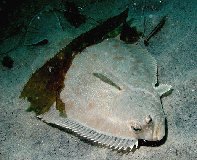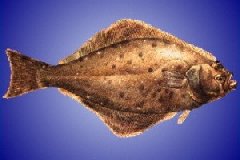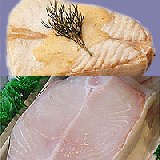Halibut
http://www.100md.com
《e Natural Health Center》
 |
 |
 |
 |
Seafood
Halibut
Latin:
Hippoglossus hippoglossus
Origin:
Halibut belongs to any of various flatfishes (order Pleuronectiformes), especially the large and valuable Atlantic and Pacific halibuts of the genus Hippoglossus. Both, as long, slender, flatfishes, have the eyes and color on one side of the body, with the left eye on the side of the head. The blind side is significantly pigmented. Both, as members of the family Pleuronectidae, usually have these features on the right side. So they are also called "right-sided" flatfish.
, http://www.100md.com
The Atlantic halibut (Hippoglossus hippoglossus) is found on both sides of the North Atlantic. The largest flatfish may reach a length of about 2 metres and a weight of 325 kilograms. It is brown, blackish, or deep green on the eyed side and, like most other flatfishes, usually white on the blind side.
In some areas, it has become scarce because of overfishing. The Pacific halibut (Hippoglossus stenolepis) is smaller and slimmer than the Atlantic form and is found on both sides of the North Pacific. A greenish-brown fish, it may reach a weight of about 213 kilograms.
, 百拇医药
Breeds in April-July in depths of 700-2,000 m, the young inhabit waters of 50-200 m until 12-25 cm, when they move into deeper water. The halibut can be found in very deep water (to 2,000 m), where it swims "upright", like a normal fish.
Atlantic halibut, caught mostly as a by-catch of other fisheries, has a delicate flavor and firm texture. Pacific halibut, caught as far north as Alaska, is milder in taste than Atlantic halibut. Greenland turbot and California halibut are large flatfish that are often sold as halibut; they possess softer flesh.
, http://www.100md.com
The halibut hunts codling and smaller species of fish, and also takes deep-sea prawns. It is a mild, firm-textured fish; its cheeks are particularly tender and delicious.
Most halibut is available fresh as steaks, fillets, or roasts; however, much halibut has been frozen.
Fresh Pacific halibut is available in the spring and summer; fresh Atlantic halibut is available sporadically. Frozen halibut is available year-round.
, 百拇医药
Properties:
Functions:
Applications:
For deficiency of spleen-pancreas qi:
If the deficiency is severe, small amounts of halibut prepared in a soup or congee may be helpful.
Dosage and Administration:
Frozen halibut should be cooked without thawing as it tastes fresher than thawed fish. The secret to successful halibut cookery is to not overcook. Whichever of the following cooking methods you choose, your halibut will be cooked when the flesh becomes opaque but is still moist and can easily be pierced with a fork.
, 百拇医药
Baking: Place halibut in a greased baking dish, or wrap in oiled foil and place on a baking sheet. Brush with melted butter or oil and season with salt and pepper, or cover with a piquant sauce. Bake in a preheated 230° C oven until done, about 10 minutes for each 2.5 cm of thickness.
Broiling: Rinse halibut fillets or steaks and pat dry with a paper towel. Place fish on a rack above a baking dish, and brush with melted butter or oil. Preheat broiler and adjust oven rack so fish is 7.6 to 10 cm from the element. Broil, turning once, until fish is opaque but still moist in the center, about 6 to 10 minutes, depending on size of the fish.
, 百拇医药
Grilling: Halibut fillets or steaks may be placed directly on a greased grill; Greenland turbot should be supported by perforated aluminum foil. Grill 10 to 15 cm above prepared coals or fire. Baste with butter, oil, or marinade and close hood of grill. Cook until fish is opaque and moist on the inside, about 6 to 8 minutes for fish less than 2.5 cm thick, and 10 to 15 minutes for fish larger than 2.5 cm thick.
Pan frying: Coat halibut with seasoned flour, crumbs, or cornmeal. Shake off any extra coating and fry in a small amount of hot butter or oil, turning once halfway through cooking time. Cook until opaque and moist on the inside, 4 to 8 eight minutes.
, 百拇医药
Deep frying: Pour oil into a wok or deep fryer; it should be at least 3.8 cm deep, and the cooker should be less than half full of oil. Heat oil to 190° C, using a thermometer to monitor temperature. Cut boneless strips into similar sized pieces about 3.175 to 3.8 cm thick. Dip in batter, drain, and then slip pieces into hot oil. Cook until brown, 2 to 3 minutes.
Poaching: Bring poaching liquid, consisting of water, broth, herbs, and spices, to a simmer. Slip the halibut in, then cover pan and keep liquid at a simmer for about 8 minutes per 2.5 cm of thickness.
, 百拇医药
Quality halibut is easy to recognize. It smells fresh, like the ocean, and has firm white flesh. Keep halibut cool on the trip from the market to your house. Never let it stay unrefrigerated for long.
To store halibut, remove the packaging, rinse fish under cold water, and pat dry with paper towels. Fish deteriorates when it sits in its own juices, so place it on a cake rack in a shallow pan filled with crushed ice. Cover with cling wrap or foil and set in the coldest part of the refrigerator. Halibut will store well this way for up to two days.
, 百拇医药
When well-wrapped, halibut can be frozen for up to two months in a refrigerator freezer and three to four months in a deep freeze. Use lined freezer paper, and wrap the fish tightly from head to tail with at least two layers of paper.
To thaw slowly, unwrap the fish, place in pan, cover, and leave for 24 hours in the refrigerator. To thaw more quickly, place the whole fish (wrapped in a watertight bag) in a sink with cool running water, allowing about 30 minutes per 450 g. For fastest thawing, use the defrost cycle of your microwave, allowing two to five minutes per 450 g, with equal standing time in between zaps (as one minute defrost to one minute resting).
, 百拇医药
Cautions on Use:
Reference Materials:
Toxic or Side Effects:
Modern Researches:
Every half fillet of halibut (155 g) contains 223 calories, 42.4 g protein, 4.7 g fat; and is an excellent source of potassiium (916 mg), selenium (74.4 mcg), vitamin B6 (0.63 mg), and vitamin B12 (2.2 mcg).
When cooked (dry heat), both Atlantic and Pacific halibut provide 0.548 grams of omega-3 fatty acids, derived from EPA (0.091g), DHA (0.374g), and ALA (0.083g) per 100 grams of Atlantic and Pacific halibut., 百拇医药